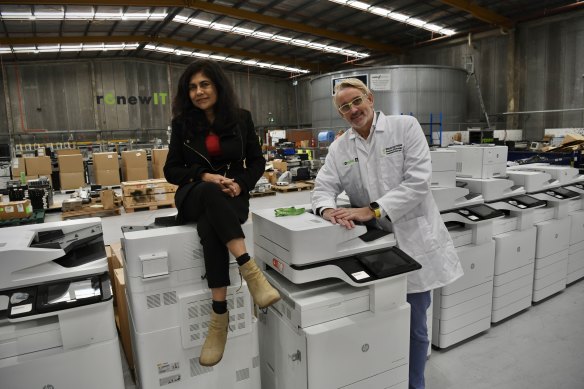- Exclusive
- Environment
- Sustainability
- Inventors
This was published 11 months ago
These plastics were ‘unrecyclable’. An Australian invention is changing that
Veena Sahajwalla has a knack for turning trash into treasure. In 2003, the University of NSW engineering and science professor invented a pioneering technology to make “green steel” by using old car tyres.
Her philosophy for her work at the university’s Centre for Sustainable Materials Research and Technology (SMaRT) is simple: “When we look at waste materials, we don’t actually see it as waste,” she said. “We see it as a resource.”

University of NSW’s Professor Veena Sahajwalla and Renew IT chief executive James Lancaster in his warehouse of old office equipment.Credit: Dean Sewell
So it was no surprise that James Lancaster turned to Sahajwalla and her team to help deal with the growing mountain of obsolete office equipment at his electronic waste recycler, Renew IT.
Lancaster, the business’s chief executive, had a warehouse filled with printers, computers and modems destined for landfill because they contained hard plastics regarded as unrecyclable.
“Electronic goods like televisions, computers and printers are being produced in ever-increasing numbers and often with increasingly short life cycles,” he said. “When they do reach end of life, the waste industry’s solution has been to deliver them to landfill.”
About 90 per cent of hard plastics found in electronic goods end up in a tip, but Lancaster said that is not a solution that sits easily with him.
At one end of his company’s headquarters in Sydney’s Lane Cove – on a site that formerly housed a fast fashion import business – sits a groundbreaking invention that promises to give new life to hard plastics.
The Plastic Filament MICROfactorie, which Sahajwalla developed with her team, transforms plastic parts from office equipment into long spools of filament that can be fed into 3D printers.
“It has been years in the making with many ups and downs, and now seeing the team at Renew IT and SMaRT operating the Filament Microfactorie and making it work really makes you step back and smile,” Sahajwalla said.
SMaRT’s Head of Microfactories, Anirban Ghose, said old office equipment was disassembled to find the “right plastic to go after”, which was then fed into the “microfactory”.
“That plastic gets thermally transformed through controlled heat and cooling, and it’s finally spooled and can get fed into a 3D printer at the end of the process,” he said.
It sounds deceptively simple, but the process of transforming a material regarded as waste into a high-quality product for 3D printing requires a strong foundation of science and engineering.
“In many cases, when people think about plastic, it’s just this kind of one single material,” Sahajwalla said. “But there are so many different versions of plastic.”
Her challenge was working out a way to safely transform the plastic from obsolete computers and printers into a material that could be remanufactured in a commercially viable way.
An early version of the technology produced material that was turned into a pair of spectacles gifted to the Indian leader Narendra Modi by former prime minister Malcolm Turnbull.
“We were able to show that our technology was fit for purpose,” Sahajwalla said.
The development of the microfactory follows the collapse of the REDcycle scheme that led to 400 tonnes of soft plastic being sent to landfill, impacting consumer confidence.
Sahajwalla said the invention had the potential to restore public faith in recycling and reduce landfill.
3D printing has previously been mostly reliant on virgin plastics.
“Filament is almost entirely imported to Australia, so being able to locally make it from used plastics also reduces the environmental impacts from global freight,” Sahajwalla said.
Lancaster said it could also help organisations lower emissions and bring manufacturing to Australia.
“If 3D printing feedstock can be competitively produced by recycling plastic, we shouldn’t be producing it with virgin materials,” he said.
The Examine newsletter explains and analyses science with a rigorous focus on the evidence. Sign up to get it each week.